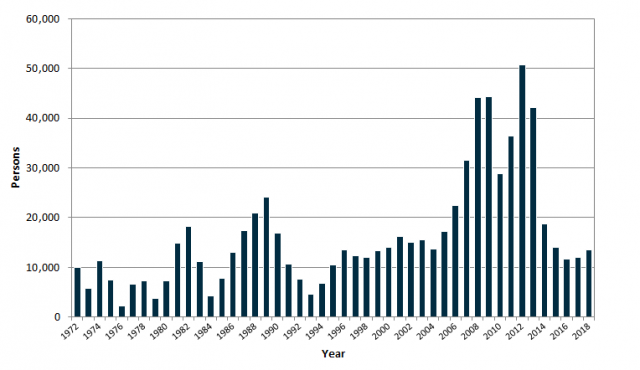Overseas migration is the most volatile component of population change to the Australian population. There has been a significant variation in the net overseas migration gain to Australia over the last 30-40 years. The pattern has tended to follow economic cycles and Australia has just come through a period of unprecedented immigration gain. Now that the economic situation have changed, what assumptions are we making about future levels of migration?

Migration levels tend to rise and fall on a cyclical basis depending on factors such as:
- The economic cycle
- Demand for labour
- Government policy
- Push factors from outside Australia (such as large numbers of refugees seeking refuge)
- Relative economic opportunities in Australia compared to other developed nations, such as the United States, Canada, Western Europe and New Zealand
As the chart below shows, there has been a significant variation in the net overseas migration gain to Australia over the last 30-40 years. The pattern has tended to follow economic cycles. The recent very high levels of overseas migration are unprecedented. The levels have emerged as a result of a period of sustained economic growth, historically low levels of unemployment and with notable labour shortages being recorded in many industries. This has been coupled with a significant increase in the overseas student market, which has allowed a large number of people to enter Australia as fee-paying students and then apply for residency and citizenship after completing various courses whether at universities or private colleges.

Source: ABS, Australian Demographic Statistics, various editions (Cat. No. 3101.0)
Recent data provides somewhat contradictory evidence for the short to medium-term future for overseas migration. The current rates of net overseas migration gain are still very high compared to longer-term rates, but the likelihood of these rates being maintained is somewhat controversial. The Commonwealth Government has reduced the number of reserve professions through which one can easily attain permanent residence status in Australia. As a consequence, demand for tertiary and trade courses from overseas has dropped strongly. The assumption is that this will reduce net overseas gain in the coming years to lower levels.
However, Australia has emerged from the so-called Global Financial Crisis with relatively low unemployment rates. A changing economic climate could be a major threat to this situation, given that the global recovery has been slow and the Government is clearly having problems managing the so-called ‘two-speed economy’. Rampant growth in mining and associated industries has been offset by struggling retail and manufacturing sectors. Tourism and export-oriented business are also jeopardised by the high Australian dollar. By contrast, however, Australia is also experiencing an increased share of the population ageing into the retirement age groups (60+ years). This could create further skill shortages as people leave the labour market, a potential fillip for overseas migration.
Another factor that must be considered is the domestic political environment. While Government policy on immigration tends to reflect more practical or pragmatic economic considerations, there is currently a great deal of negative publicity in relation to population growth, immigration levels and refugees in the media. At times, this publicity and the political environment affect the migration program more directly than at others.
.id’s tops-down population forecasts for Australia (SAFi) have adopted a medium and long-term assumption of 200,000 persons per annum. This may seem to be a high number, given the uncertainty of the current economic environment and the historical rates of overseas migration. However, it is likely that the underlying demographic changes and potential employment shortages will result in a greater demand for overseas migration. The needs of the Australian labour force tend to be the most important determinant of immigration policy in Australia.
For more information about population forecasts feel free to contact the population experts at .id (03) 9417-2205 or info@id.com.au. And do follow us on Twitter @dotid or check out our website at id.com.au for more information about population change in Australia.











